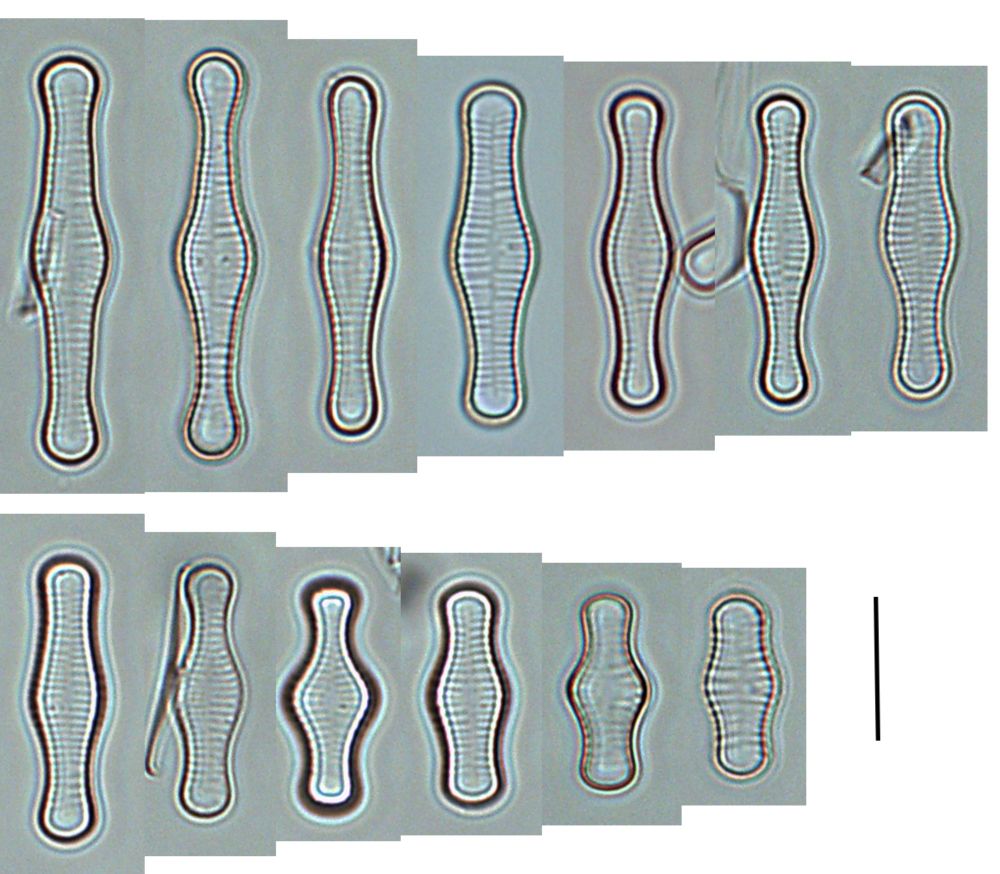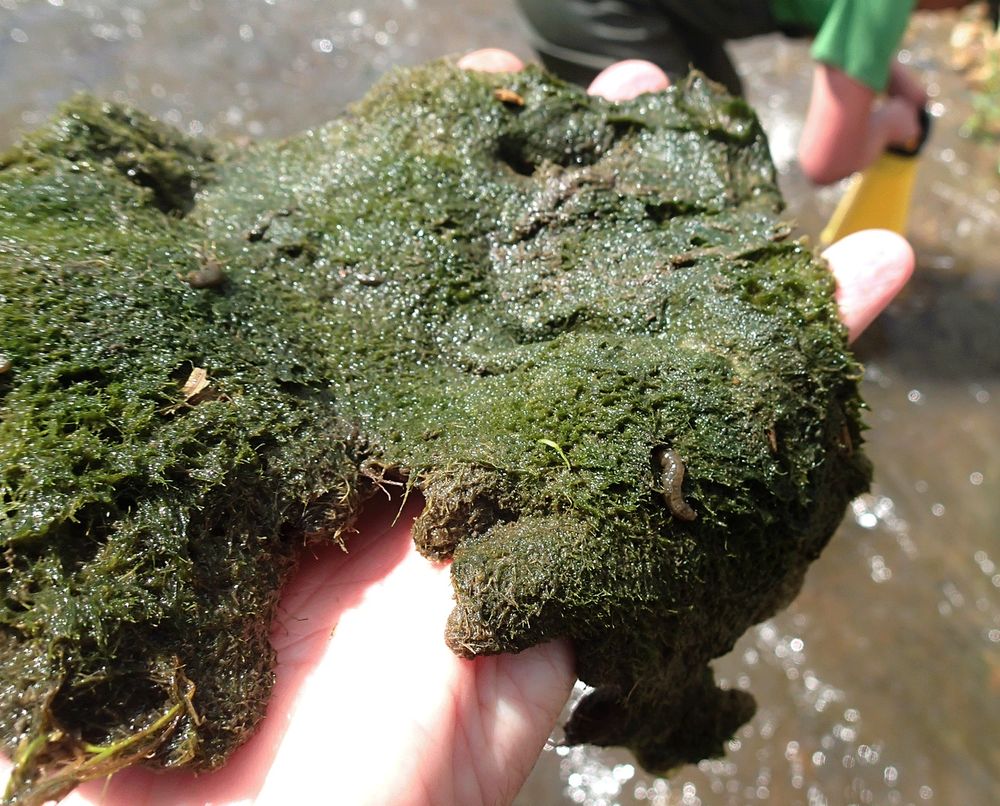
Right under our noses …
I was quite excited by the discovery I wrote about in the previous report. It is not often that we find a new record quite as intriguing as this one, and it captures the essence of my message in “…
Another post, another new diatom species. This one, though, has been hiding in plain sight for a long time. Sometimes new discoveries just involve rearranging the neurons in our visual cortex and temporal lobe: bit.ly/4pvaFCG
20.09.2025 14:53 — 👍 1 🔁 0 💬 0 📌 0

Stranger things …
As the previous two posts show, those of us who study algae are still apt to be surprised from time to time. This is not a group where basic understanding of organisms and their distribu…
Nature continues to surprise us, and this post describes the discovery of an unusual chrysophyte growing in a chalk stream this summer (I normally associate them with remote mountainous areas in winter): bit.ly/48gEbpD
14.09.2025 05:34 — 👍 2 🔁 0 💬 0 📌 0

This summer has turned our rivers into an "all inclusive resort" where algae can sunbath on river beds and generally enjoy life. They are not necessarily a homogeneous mass, and this post describes the variation I found in one river in northern England: bit.ly/4g8dLs1
06.09.2025 09:26 — 👍 1 🔁 0 💬 0 📌 0
This was part of a nationwide CS project, with Herts Wildlife Trust as local partners. Vaucheria almost never fruits in rivers - that’s its superpower - so we don’t know which species we’re dealing with. Richard Lansdown has had some success but we haven’t given him anything from the Beane.
26.08.2025 17:36 — 👍 0 🔁 0 💬 1 📌 0

Blinded by the light …
One of the themes of this blog is of the importance, for an ecologist, of making repeated visits to a site in order to see it in all its moods and tempers. And so it was that I cam…
Long, warm summer days create the perfect conditions for filamentous algae to grow in lakes and rivers. What does this mean for the anticipated spread of data centres to fuel our appetite for AI? bit.ly/4fYxt9J
26.08.2025 17:27 — 👍 1 🔁 0 💬 0 📌 0
Those who have followed my "verdant rivers" series on www.microscopesandmonsters.wordpress.com may be interested to see this newly published paper. Well done to Hannah and thanks for including me in the team:
aslopubs.onlinelibrary.wiley.com/doi/10.1002/...
13.08.2025 12:58 — 👍 1 🔁 0 💬 0 📌 0

Reflections on why #Vaucheria mats proliferate in some types of British river in my latest post:
bit.ly/3JaKela
10.08.2025 15:58 — 👍 3 🔁 0 💬 1 📌 0

Gateway to hell …
This is a brief postscript to the posts I wrote based on my visit to a hot spring in Tunisia last year (see “Life in hot water …” and “hot diatoms …”) prompted by a reference to hot springs in the …
Never able to resist a diversion, this post continues from my explorations of hot springs in Tunisia last year with some evidence that Augustine of Hippo was also aware of life in these extreme habitats, and that this may have informed his (and, therefore our) conception of hell: bit.ly/4kAhJKw
14.07.2025 06:34 — 👍 2 🔁 0 💬 0 📌 0
"The perfect storm" is quite a good metaphor for the way several factors combine to cause algal proliferations in UK rivers. Except that the absence of storms (and associated spates) is part of the problem:: bit.ly/4nS2TCn
07.07.2025 05:18 — 👍 1 🔁 1 💬 0 📌 0

Living rocks, gently rolling …
A trope in film noir where the protagonist is seduced by a femme fatale which came to mind when I was in Ambleside earlier in June. There were signs of a surface cyanobacterial scum in Windermere…
I'm trying to write some posts that give Cyanobacteria their due respect as natural components of freshwater ecosystems, rather than as perpetual "villains" of the eutrophication franchise. This post describes the formation of oncoids - mini stromatolites - in a Cumbrian quarry: bit.ly/4487Cb4
01.07.2025 07:30 — 👍 2 🔁 0 💬 0 📌 0

Teesdale’s unseen natural history …
We followed on of our favourite walks through Teesdale a couple of weeks ago, finishing at Widdybank Fell, beside Cow Green Reservoir, where sapphire blue spring gentians were sprinkled across the …
Reflections here on how the statement "“In the end we will only conserve what we love, we will love only what we understand, and we will understand only what we are taught” applies to the much-maligned Cyanobacteria: bit.ly/3H0cKVA
19.05.2025 16:09 — 👍 0 🔁 0 💬 0 📌 0

More speculation about the life of a shade-loving diatom in my latest post: bit.ly/41TbPhO
31.03.2025 15:30 — 👍 0 🔁 0 💬 0 📌 0

Just found my 1980s version of ggplot …
22.03.2025 11:25 — 👍 3 🔁 0 💬 1 📌 0

Here's a puzzle: a Eunotia that has many small discoid chloroplasts, rather than the two plates that the (limited) literature on live diatom identification tells us to watch out for. bit.ly/3Rd2qLH
17.03.2025 07:45 — 👍 0 🔁 0 💬 0 📌 0

Darkness at the edge of streams …
The snow dusting the tops of the Lake District fells as we drove towards our field sites presaged a day of brutally cold conditions although, thankfully, the long period of high pressure that has s…
Stumbled across some Eunotia formicina during recent field work and started wondering why it occurs in a few locations, but is absent from similar sites upstream and downstream. No answers, just a few ideas ... bit.ly/4h44jox
27.02.2025 18:44 — 👍 0 🔁 0 💬 0 📌 0
We’ve all heard people say “I saw history happening” in response to an event. Yesterday, I think we saw histiography happening in front of our eyes too.
21.01.2025 11:17 — 👍 0 🔁 0 💬 0 📌 0
Add me in, please! Martyn
14.01.2025 13:36 — 👍 1 🔁 0 💬 1 📌 0
LinkedIn
This link will take you to a page that’s not on LinkedIn
I contributed to two multi-authored papers that, by coincidence, both appeared this week, lnkd.in/e6Bbe3_X and lnkd.in/e6YdJsJy, with authors from no less than 24 countries spread across five continents. That's a nice way to start 2025.
10.01.2025 16:35 — 👍 0 🔁 0 💬 0 📌 0
I wasn't 100% sure about this myself, to be honest. Maybe the mountants are just an incremental change on from the first diatomist who thought that dropping diatoms into strong oxidising agents would be better than looking at them in their live state?
28.12.2024 15:43 — 👍 0 🔁 0 💬 0 📌 0

Diatom taxonomy in five paradigm shifts …
The second module of “Diatoms 101” addresses how to identify diatoms but, before we look at the important features of diatom cells, I need to address the reasons why newcomers to diatoms often find…
The next stage of my "Diatoms 101" series of posts addresses identification but first I want to explain why #diatom names are forever changing. I've tried to encapsulate this in five "paradigm shifts". I'd love to hear your thoughts too, whether agreeing or suggesting alternatives. bit.ly/407upBL.
27.12.2024 17:51 — 👍 6 🔁 1 💬 0 📌 1

Friends with benefits/
For the next post I walked from the side of Ennerdale Water to the edge of the River Ehen, into which the lake discharges. I’m barely three hundred metres from the weir that marks their …
I'm lucky to have an opportunity to revisit the same sites over a number years to follow seasonal trends in stream diatoms. Tabellaria flocculosa shows different patterns in different streams within the same region, which I cannot fully explain (though I do make some guesses ....): bit.ly/4gDpUEI
21.12.2024 11:54 — 👍 4 🔁 0 💬 0 📌 0

A cold case …
Fieldwork last week was simultaneously brutal and wonderful: air temperatures were barely above freezing and river levels were just high enough for an injudicious plunge to grab a stone to result i…
A very cold day of fieldwork in the Lake District last week resulted in some spectacular views, numb fingers and an observation of Didymosphenia colonies growing in the littoral zone of Ennerdale Water: bit.ly/49M7r6A
16.12.2024 08:20 — 👍 1 🔁 0 💬 0 📌 0
A society devoted to the study of algae founded in 1952 🌱🔬
Marine plankton, home educator, biology undergrad, autistic, non binary. Norfolk UK. Runs The Plankton Project
linktr.ee/elizabethbeston
Freshwater biologist. #1 rotifer enthusiast. Trained by canine masterminds to dispense treats and open doors on command.
https://desp.ucdavis.edu/people/stephanie-hampton
Ecosystem scientist | Biogeochemist | Lake Dr. | Assistant Professor at University of Colorado Boulder | 🏳️🌈🇵🇱
https://www.mountainlimnologylab.com/
Research Limnologist at USGS | Prev @USGS Mendenhall Fellow @WSUPullman @NSF #GRFP @FulbrightPrgrm @SLU_Official | Co-founder, org-team member of @HackingLimno 🏳️🌈
Limnologist and Associate Professor at UW-Madison. Canadian-American. Pocket and labrador enthusiast.
Professor in the Department of Biology at York University researching the impacts of climate change on lakes. Inaugural Academic Director of the United Nations Institute for Training and Research (UNITAR) Global Water Academy.
Water researcher 💧, teacher 🍎, volunteer trying to build better communities ✋🏼, dad 🧓🏼, rides bikes 🚲.
Isotopes, fish, footy and more isotopes.... Prof at University of New Brunswick
Professor in Aquatic Ecology @ University of Vermont (UVM) & Director of the Rubenstein Ecosystem Sci Lab on Lake Champlain; DVM = Diel Vertical Migration
PhD candidate @CornellEEB |
MS in Freshwater & Marine Science @UW-Madison Center for Limnology |
Wisconsin’s biggest fan
Professor @virginia_tech | Freshwater ecosystems & data science | Studying and forecasting the ecology of lakes and reservoirs in a changing world | carey.biol.vt.edu
Great Lakes limnologist; Prof Algoma Univ; past IJC Science Advisory Bd member; former IAGLR Pres. Watermark story: https://vimeo.com/180232420; Water-Sky image: @christibelcourt.com; inset is marine diesel in Great Lakes at dawn. Water & oil don’t mix.
Lover of lakes, the bigger the better.
Professor in Physical Geography at the University of Nottingham
Researching aquatic ecosystems in New York and beyond.
Smithsonian Climate Change Fellow | aquatic biogeochemistry, carbon cycling, and ecological forecasting | she/her
https://serc.si.edu/staff/abigail-lewis
https://abbylewis.github.io/
Global Change Aquatic Scientist | Grew up in USA, lives in Germany, misses Tanzania | sites.google.com/view/benjaminkraemer/home
Interested in lake ice & changing lake ecology 🌊 ❄️ she/her
Wherever there's water | Microbial Ecology |Biogeochemistry | Asst Prof | #firstgen | whereverthereswater.org | opinions are my own























